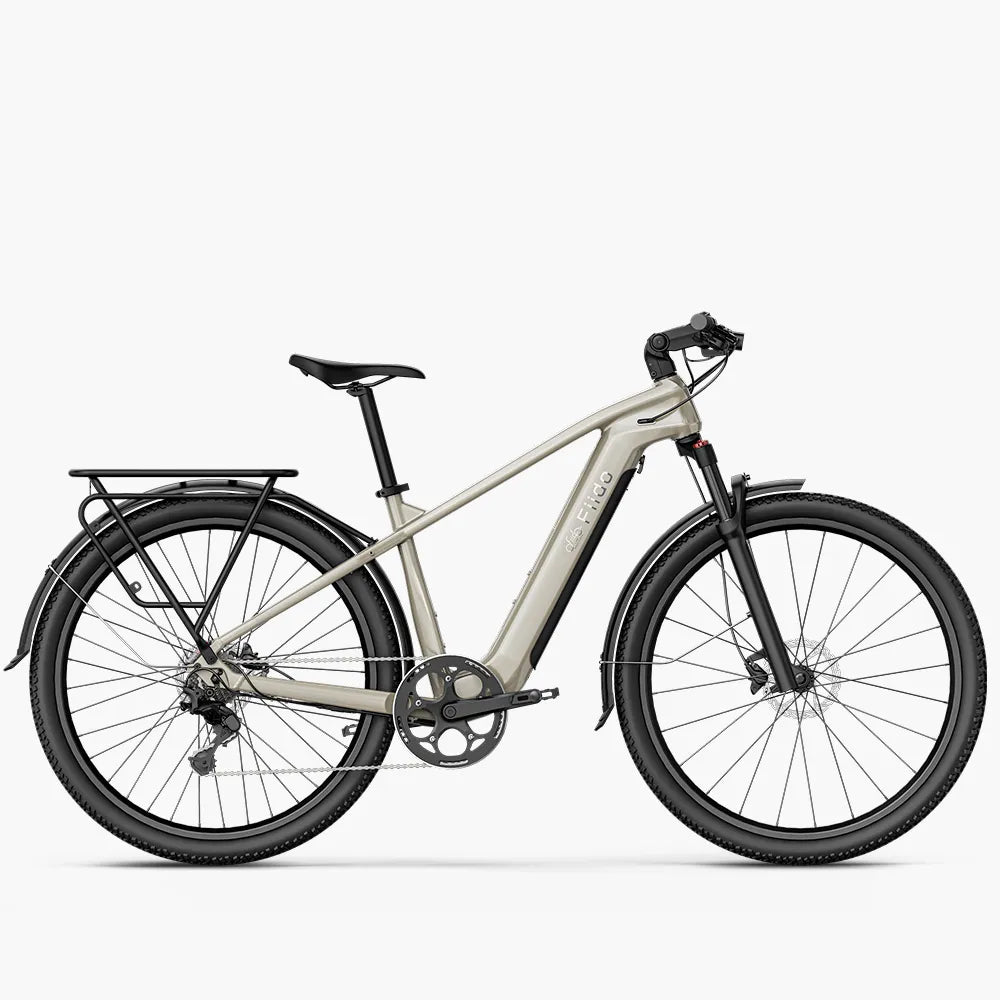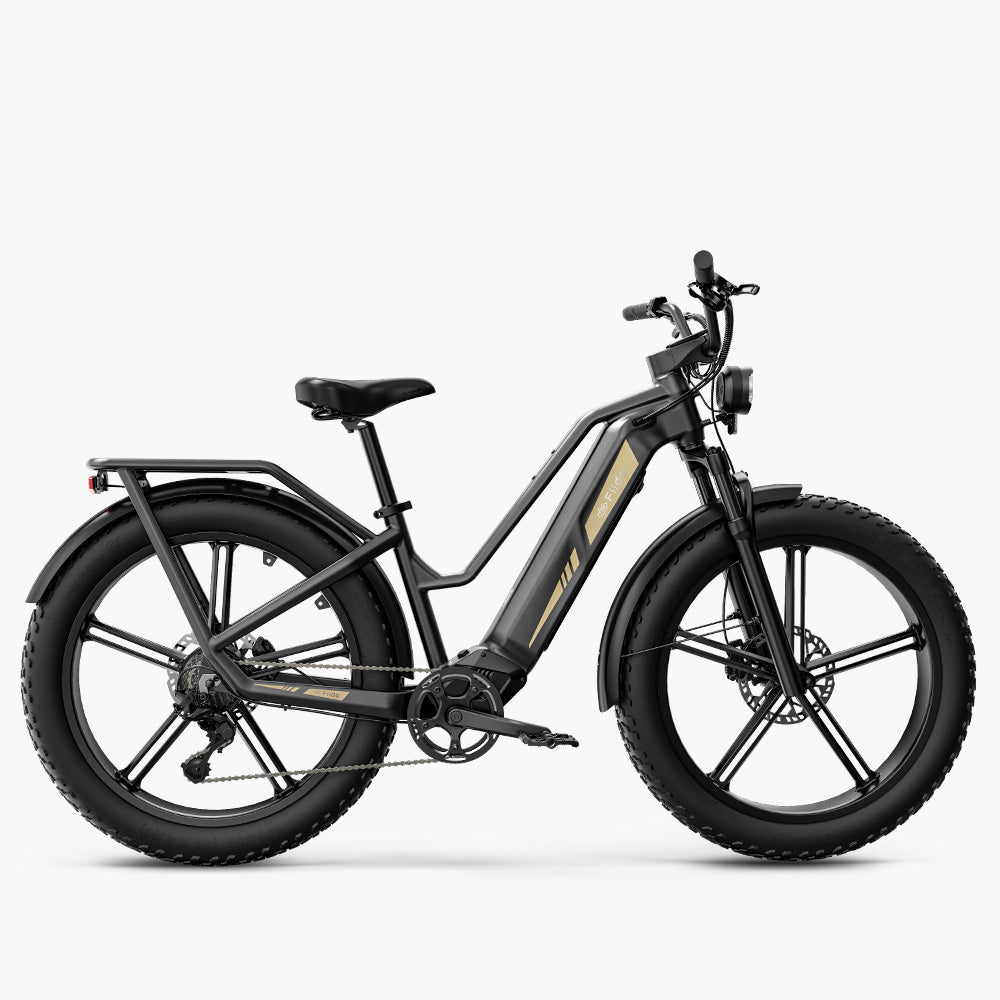
A trekking e-bike is a versatile electric-assist bicycle designed for long-distance rides and mixed terrain. It typically features wider tires, suspension components, and multi-speed gearing, allowing it to handle everything from paved roads to gravel paths and light off-road trails. This makes it a great choice for commuting, leisurely rides, or short touring adventures.
But with so many models and specs available, you might be wondering: which bike suits my usual routes best? Will the battery range be enough? How do I choose the right suspension and tires? And will it actually be comfortable to ride? Don't worry — this article will break down the key features to help you find the trekking e-bike that truly fits your needs.
What Types of Trekking E-Bikes Are There
Trekking e-bikes don't come in just one style — they generally fall into three main categories based on how you plan to use them:
Urban commuting models – These are lightweight, with smoother power assistance, ideal for medium to long-distance rides on paved city roads
Touring or long-distance models – Built for multi-day adventures, they offer larger battery capacity and a more robust frame to handle heavy gear and longer journeys.
Light off-road models – These lean closer to mountain bikes, featuring wider tires and stronger suspension systems. They’re perfect if your route occasionally includes forest trails, gravel paths, or rougher terrain.
When choosing a trekking e-bike, understanding these differences is key — the right type depends entirely on your riding habits and where you plan to go.

How to Choose the Key Features of a Trekking Electric Bike
Beyond picking the right type, it's essential to understand the key components that directly affect your riding experience:
Battery – The battery capacity determines how far you can ride on a single charge. For daily commuting, a minimum of 500Wh is recommended. For weekend trips or longer rides, aim for 625Wh or more. Some premium models even support dual-battery systems, making it possible to ride over 100 km without recharging. For example, the Fiido Titan and Nomads support 3-battery structure swapping, offering a range of over 200 km.
Suspension system – If your route often includes uneven surfaces like gravel paths in parks, cobblestone roads in residential areas, or rolling countryside trails, a front suspension fork will greatly improve comfort. The fork helps absorb shocks from bumpy terrain, reducing strain on your wrists, shoulders, and upper body. This is especially useful when going downhill or picking up speed, as suspension increases stability and safety.
However, not all suspensions are always active. Some models include a “lockout” feature that allows you to switch off the suspension when riding on smooth city roads or climbing hills. In these cases, active suspension may waste your pedaling energy. Think of it like driving: a springy seat is great for rough roads, but on a highway, a firm suspension provides better efficiency and control.
Tires – Tire size and width significantly influence your comfort and handling. For instance, markings like “700×40C” (French standard) or “28×1.75” (Imperial system) show two things: the number “700” or “28” refers to the rim diameter (typically around 28 inches or 700C), affecting rolling efficiency; while “40C” or “1.75” represents tire width. Wider tires offer better grip and cushioning, which is ideal for varied terrain, but they also create more rolling resistance. Choose based on your typical road conditions and your personal preference between comfort and efficiency.

Buying Advice: Choosing the Right Trekking E-Bike
If you're looking for an electric bike that's great for both city commuting and weekend touring, we recommend the Fiido Nomads Touring E-Bike. It comes with 29×2.1" tires that roll smoother and with less resistance compared to fat tires—ideal for long-distance pedaling or daily rides. The bike weighs just 24.7 kg, and its lightweight aluminum frame paired with reliable hydraulic disc brakes ensures safe and nimble handling.
For comfort, the front hydraulic suspension fork offers a generous 120mm of travel, which easily soaks up bumps on forest trails or gravel paths—perfect for keeping your ride smooth and your body pain-free, even over long hours.
The torque sensor adds to the natural feel of pedaling by accurately detecting how hard you push the pedals and adjusting the motor support accordingly. In pedal-assist mode, one battery gives you up to 80 km of range, and with support for three swappable batteries, you'll have no trouble covering long commutes or short touring trips.
Fiido Nomads Touring E-bike
Long-range electric touring bike for comfortable, all-terrain travel and city exploration.
Reminder: Prices are subject to the product detail page ,some earlier card details may have been updated.
If you need an electric bike that can handle both light off-road trails and heavy long-distance loads, the Fiido Titan Fat-Tire All-Terrain E-Bike is the one to go for. It's equipped with 26×4.0" extra-wide tires, giving you excellent grip and stability—even in sand, snow, or muddy terrain.
The Titan uses a front hydraulic suspension fork with 60mm travel to absorb shocks and reduce strain on your arms and shoulders. Its robust aluminum frame supports up to 200 kg (120 kg rider + 80 kg rear rack), making it ideal for carrying gear or heavy commuting loads.
Its biggest highlight is its impressive range: a single battery has a range of up to 115 kilometers, and it can support three battery replacements, delivering a total range of over 340 km—perfect for long-distance touring or even camping adventures. Add in 4-piston hydraulic disc brakes and a 9-speed drivetrain, and you've got confident control no matter the climb or descent.
Fiido Titan Robust Cargo Electric Bike
A powerhouse with a 248-mile range and 4-piston brakes, ideal for hunting and fishing trips.
Reminder: Prices are subject to the product detail page ,some earlier card details may have been updated.
Final Tips
While trekking e-bikes are ideal for multi-day trips, it's best to start with a few shorter local rides—around 20 to 50 km loops—to get used to the bike's structure, the rhythm of electric assist, and the feel of the suspension. To ensure a smooth and enjoyable trekking journey, you'll also need to prepare beyond the bike: wear lightweight, breathable cycling gear, plan your route and rest stops, carry water and energy snacks, pack basic repair tools, and make sure your phone or navigation device is fully charged. Don't overlook safety—inform someone of your route before departure, and equip your electric bike with front and rear lights and reflective gear. Proper preparation means greater peace of mind and more enjoyable adventures.


















